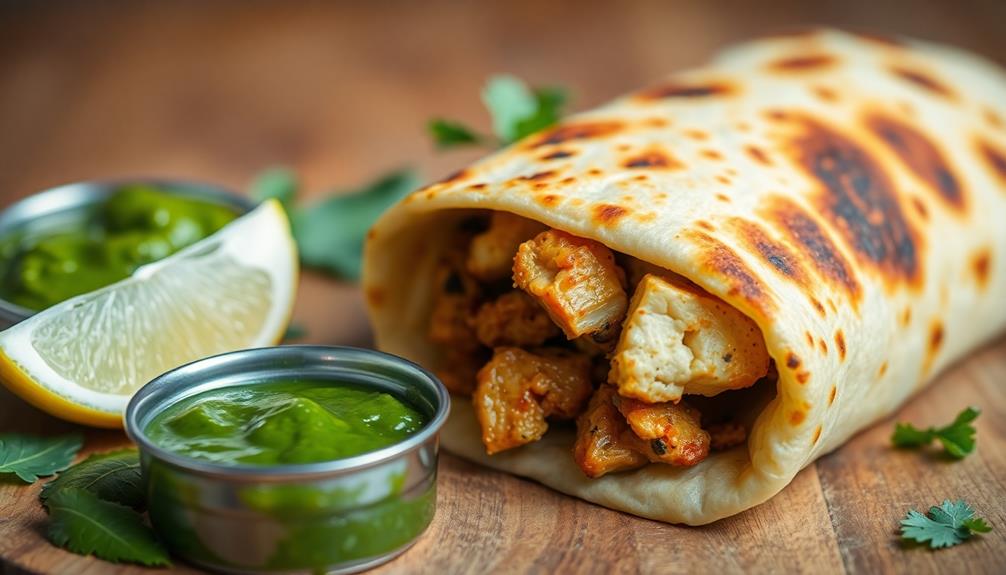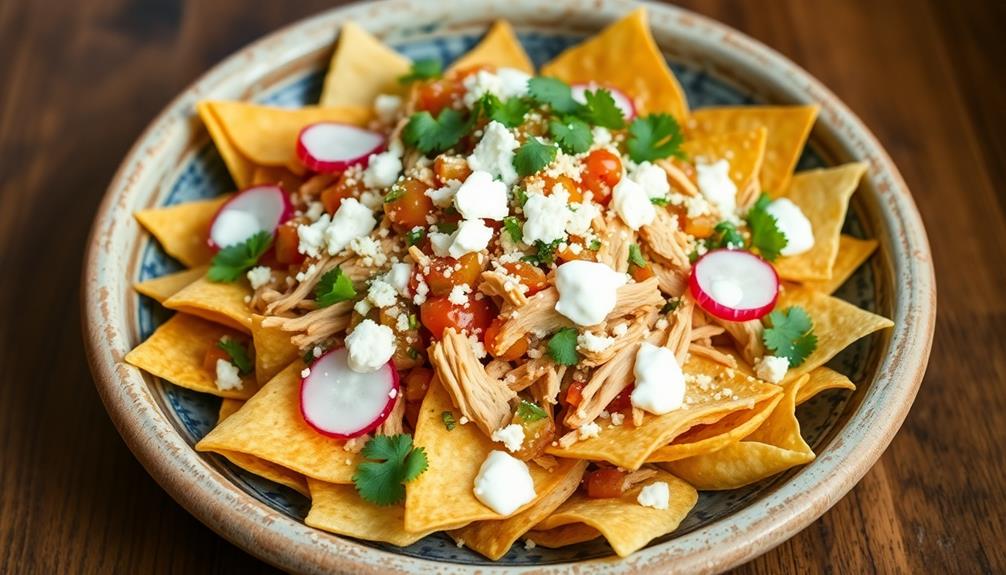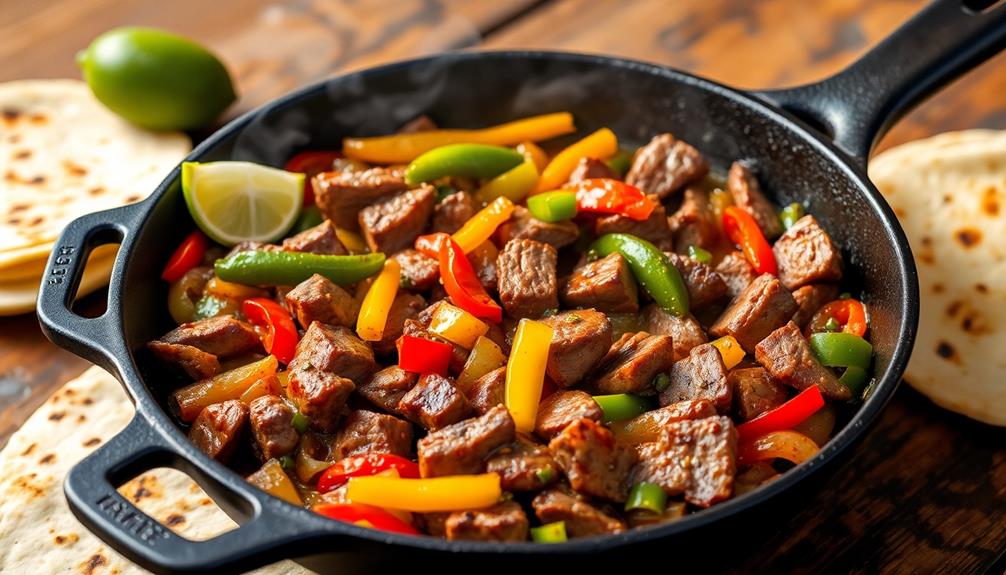Ceviche is a zesty seafood dish that'll have your taste buds dancing! This vibrant wonder dates back over 2,000 years to the ancient Incan civilizations of Peru and Ecuador. They used fresh fish and tangy citrus fruits to create the earliest versions. The Spanish later brought ceviche to Europe, sparking tasty variations worldwide. Peru's ceviche is known for its bold, spicy flavors, while Mexico offers mellower versions. Today, this healthy, flavor-packed dish is loved globally – you can often find it at restaurants and food festivals. Curious to learn more about ceviche's rich history and how to make it?
Key Takeaways
- Ceviche is a traditional South American dish that originated in coastal regions of Peru and Ecuador over 2,000 years ago, featuring fresh seafood marinated in citrus juices.
- The dish is known for its vibrant, refreshing, and unique flavor profile, combining the delicate textures of seafood with the tangy and sometimes spicy notes of lime and other ingredients.
- Key ingredients in ceviche typically include white fish, lime juice, onions, tomatoes, cilantro, and avocado, which contribute to the dish's overall balance of flavors and textures.
- The preparation process involves marinating the raw seafood in citrus juice for 30 minutes to 1 hour, allowing the "cooking" to occur without heat, resulting in a firm, opaque texture.
- Ceviche is often served chilled and garnished with additional vegetables, and is a popular dish in restaurants and food festivals, celebrated for its fresh, healthy, and flavorful qualities.
History
Originating from the coastal regions of Peru and Ecuador, the history of ceviche dates back centuries. You might be surprised to learn that this delicious dish has been enjoyed for over 2,000 years!
Ancient Incan and Peruvian civilizations were the first to create a version of ceviche, using fresh seafood and a tangy marinade made from native citrus fruits.
As Spanish conquistadors arrived in South America, they discovered this unique culinary delight and brought the recipe back to Europe. Over time, ceviche evolved, with different regions developing their own unique variations.
From the tangy and spicy ceviche found in Peru to the milder, sweeter versions enjoyed in Mexico, this versatile dish has captured the hearts and tastebuds of people all around the world.
Whether you're trying ceviche for the first time or it's a favorite of yours, you can't help but be amazed by its rich and flavorful history.
Recipe
Ceviche is a refreshing seafood dish that originated in Peru. It's made by "cooking" raw fish or shellfish in an acidic marinade, usually citrus juice. The finished dish has a bright, tangy flavor and a firm, yet tender texture.
Preparing ceviche at home is relatively easy, but it's important to use the freshest, highest-quality seafood available. This is because the raw fish is the star of the show, and the success of the dish relies heavily on its freshness.
- 1 lb fresh white fish (such as halibut, tilapia, or snapper), diced
- 1 cup fresh lime juice (about 6-8 limes)
- 1/2 cup fresh lemon juice (about 2-3 lemons)
- 1 red onion, thinly sliced
- 2 tomatoes, diced
- 1 jalapeño, finely chopped (remove seeds for less heat)
- 1/4 cup chopped cilantro
- Salt and pepper to taste
In a large non-reactive bowl, combine the diced fish, lime juice, and lemon juice. Cover and refrigerate for 30 minutes to 1 hour, stirring occasionally, until the fish is opaque and "cooked" through the acidic marinade.
Stir in the sliced onion, diced tomatoes, chopped jalapeño, and cilantro. Season with salt and pepper to taste.
When selecting the fish, look for a firm, translucent texture, and avoid any that have a strong fishy smell. The acid in the citrus juice will "cook" the fish, so it's important not to let it sit for too long, as the texture can become rubbery.
Serve the ceviche immediately with tortilla chips or crackers, and enjoy the bright, refreshing flavors of this classic Peruvian dish. For a complete Latin American culinary experience, pair the ceviche with a traditional Mexican menudo recipe. The contrast of the tangy ceviche with the rich, savory flavors of the menudo will create a truly memorable meal. Don’t forget to squeeze fresh lime juice over the ceviche for an extra burst of citrusy goodness.
Cooking Steps
First, dice the fish into bite-size pieces so it's easy to eat.
Next, marinate the fish in a tangy citrus juice – this 'cooks' the fish to perfection.
Then, add in some crisp veggies and yummy seasonings to make the flavors really pop.
Let the ceviche chill for a few hours so the flavors meld, then serve it up immediately in chilled bowls for a refreshing, zesty treat.
Step 1. Dice Fish Into Bite-Size Pieces
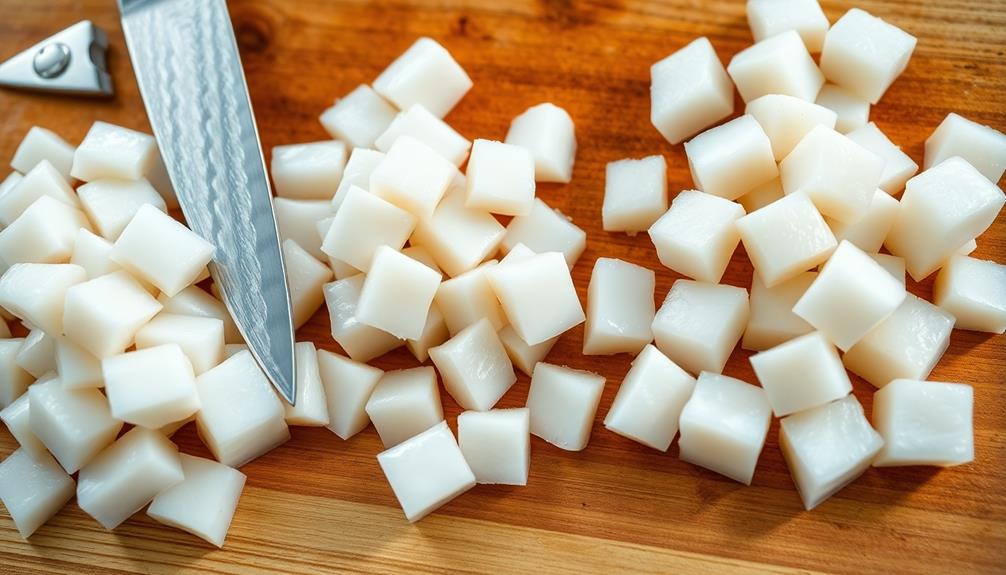
With a sharp knife, dice the fresh fish into bite-size cubes, roughly 1/2 to 3/4 inch in size. You'll want to work quickly but carefully, making sure each piece is evenly cut. This will help the fish cook evenly when it's mixed with the citrus juices later on.
Proper preparation is key, much like the careful planning needed for financial considerations for elderly care to ensure smooth transitions in life.
As you slice, try to keep the fish pieces uniform in size. This will ensure a consistent texture throughout your ceviche. Be extra gentle with delicate fish like halibut or sea bass – you don't want them to fall apart.
For heartier options like shrimp or scallops, you can cut them a little larger, about 1 inch.
Once all the fish is diced, give it a gentle toss to distribute the pieces evenly. You're now ready to move on to the next step – marinating the fish in the citrus juices! This is where the magic of ceviche really begins to happen. Get ready for bright, bold flavors that will dance on your tongue.
Step 2. Marinate Fish in Citrus Juice
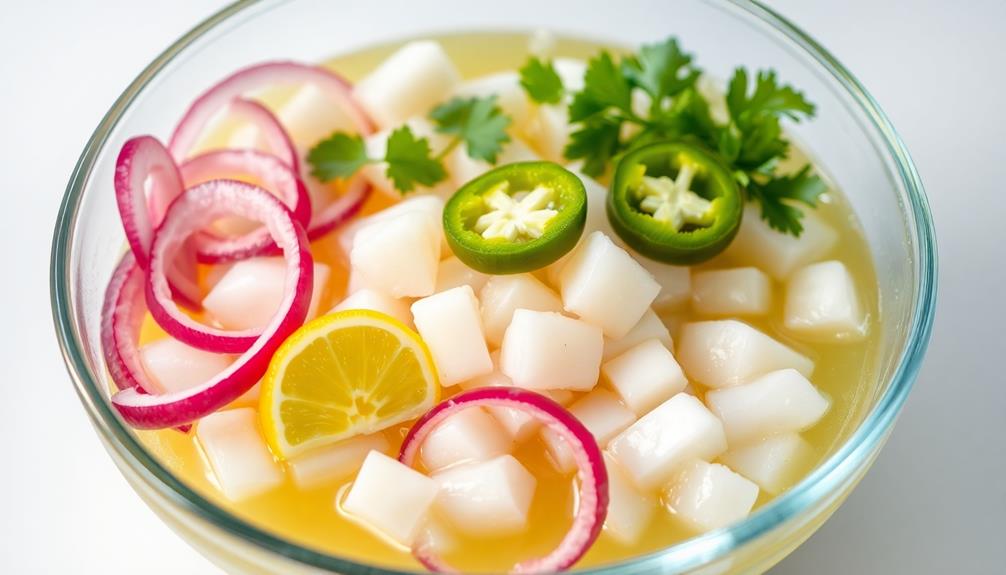
Once the fish is diced, it's time to start the flavor magic. You'll want to grab some fresh, juicy citrus fruits – lemons, limes, and oranges all work great.
Using a sharp knife, slice the fruits in half and get ready to squeeze! Drizzle the tangy, vibrant citrus juice all over the diced fish, making sure every little piece is coated.
As the fish soaks up the juice, it'll start to "cook" without any heat at all. The acidity in the citrus reacts with the fish, causing it to transform into a delightfully tender, flavor-packed delight.
Give it a gentle stir to ensure everything is evenly distributed.
Now, let the marinated fish rest for 30 minutes to an hour, allowing the flavors to meld together perfectly. The longer you let it sit, the more the fish will "cook" and soak up the bright, fresh citrus notes.
Get ready for a burst of tropical flavor in every bite!
Step 3. Add Vegetables and Seasonings

To add even more vibrant flavor to your ceviche, choose a selection of fresh vegetables to mix in. Crisp red onion, juicy tomatoes, and crunchy cucumber all make fantastic additions, bringing a lively burst of color and crunch.
Don't forget to dice them up into bite-sized pieces so they seamlessly integrate with the marinated fish.
For a little kick, mince some spicy chili peppers, like jalapeños or serranos, and sprinkle them throughout. Their zesty heat will perfectly complement the bright citrusy notes.
You can also include cool, creamy avocado cubes to balance the flavors. Fresh herbs like cilantro or parsley will make your ceviche even more herbal and fragrant.
Once you've assembled your veggies, gently fold them into the marinated fish.
Taste and adjust the seasonings as needed, adding more lime juice, salt, or even a dash of olive oil. The final result should be a vibrant, flavor-packed dish that's irresistibly refreshing.
Step 4. Chill Ceviche for Several Hours
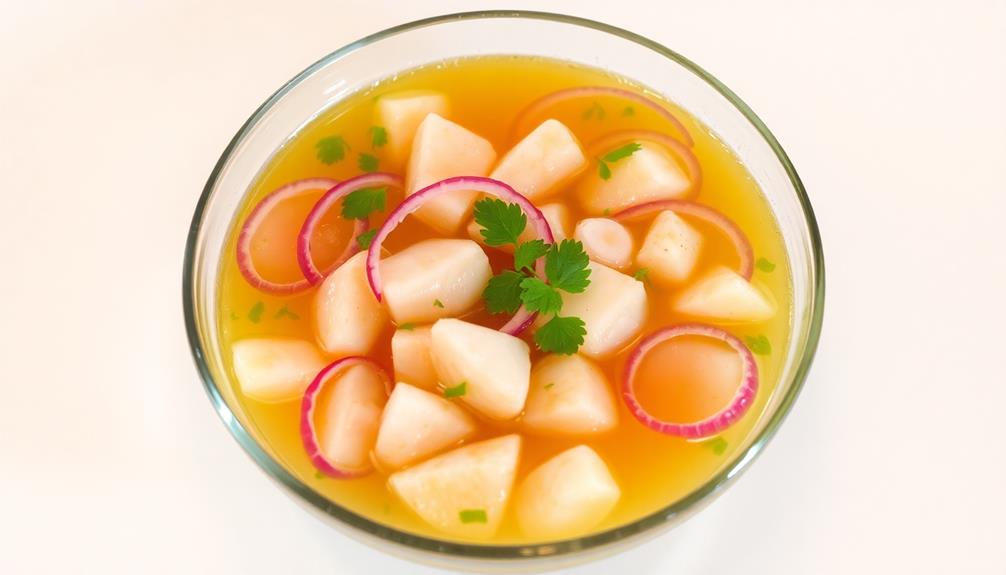
After adding your choice of fresh vegetables and seasonings, let the ceviche chill for several hours. This resting period is key to allowing the citrus juices to "cook" the fish and blend all the flavors together.
You'll want to cover the bowl and refrigerate the ceviche for at least 2-3 hours, or even up to 6 hours if you have the time.
As the ceviche chills, the acidic citrus will transform the raw fish into a delightfully tender, flavorful dish. You'll start to see the fish turn opaque and firm up as it "cooks."
The vegetables will also soften and take on the bright, zesty flavors. Resist the temptation to dig in right away – good things come to those who wait!
When the ceviche is fully chilled and the flavors have melded, it will be ready to serve. Get ready to wow your friends and family with this refreshing, citrusy seafood delight!
Step 5. Serve Immediately in Chilled Bowls

When ready to serve, ladle the chilled ceviche into individual bowls. The bright, citrusy flavors and tender fish will make your taste buds dance!
Don't forget to include a few of the diced onions, tomatoes, and cilantro from the marinade – they add lovely pops of color and texture. Serve the ceviche with crisp tortilla chips or slices of fresh avocado for a complete and satisfying meal.
The cool, refreshing ceviche is the perfect dish for a warm day. The tangy lime juice and zesty seasonings will energize your palate, while the delicate seafood melts in your mouth.
Encourage your guests to take their time savoring each bite, letting the flavors linger. You can even offer a selection of hot sauce or extra lime wedges on the side for those who want to amp up the zing.
Enjoy your ceviche masterpiece – it's a true taste of the tropics!
Final Thoughts
Ceviche, the vibrant and refreshing South American dish, has captivated culinary enthusiasts worldwide. While the preparation process may seem daunting at first, the result is truly worth the effort. The bright, citrusy flavors and delicate textures of the seafood come together in perfect harmony, creating a truly unforgettable experience. If you’re new to making ceviche, don’t be intimidated by the process. With the right ingredients and a little patience, you can create your own vibrant seafood dish that will impress your friends and family. The combination of fresh fish or shellfish, zesty lime juice, and a touch of heat from chili peppers is a winning formula that will leave you craving more.
As you dive into your chilled bowl of ceviche, you'll be struck by the vibrant colors and the enticing aroma that fills the air. Each bite is a burst of freshness, with the tangy lime juice complementing the delicate sweetness of the seafood. The crunchy vegetables and the creamy avocado add a delightful contrast, making every spoonful a delightful adventure.
Whether you're a seasoned ceviche enthusiast or a newcomer to the dish, you'll find yourself captivated by its complex flavors and satisfying textures.
Frequently Asked Questions
Is Ceviche Safe to Eat for Pregnant Women?
You should consult your healthcare provider before consuming any raw or undercooked foods during pregnancy. While some may consider it safe, it's best to err on the side of caution to protect your and your baby's health.
How Long Can Ceviche Be Stored Before It Goes Bad?
You shouldn't store ceviche for too long – it's best to eat it right away. The fish can spoil quickly, so it's generally not safe to keep ceviche for more than a day in the fridge.
Can Ceviche Be Made With Other Types of Seafood?
Yes, you can make ceviche with other types of seafood. Ceviche is a versatile dish that can be prepared with a variety of fish, shrimp, scallops, or even squid or octopus, depending on your preferences and local availability.
Is Ceviche Gluten-Free?
Yes, ceviche is typically gluten-free. Since it's made with raw fish or seafood, citrus juice, and various herbs and spices, ceviche doesn't contain any gluten-containing ingredients. It's a great option for those following a gluten-free diet.
Can Ceviche Be Served as a Main Dish?
Yes, ceviche can absolutely be served as a main dish. It's a refreshing and flavorful seafood preparation that makes for a satisfying meal. The combination of raw fish, citrus, and seasonings creates a delightful and nourishing main course.

